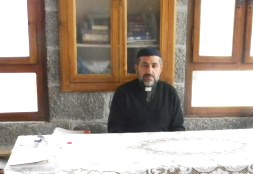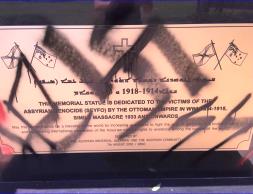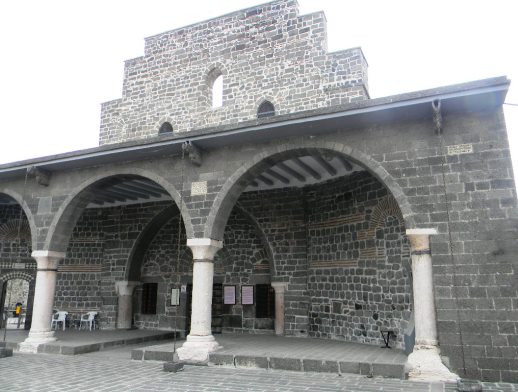
In the courtyard of the 1,700-year-old church over which he presides, Fr. Yusuf Akbulut beams with pride. He points out that the excellent stone and woodwork is a result of the craftsmanship of his ethnic group, the Syriac Christians of Turkey.
“The Syriacs were always the goldsmiths, metal workers, stone workers and artisans,” he said. “They have a tradition of being skilled craftsmen.”
Yusuf Akbulut, 50, is the priest of Diyarbakir’s Virgin Mary Church, a Syriac Orthodox congregation in southeast Turkey. He speaks Syriac as his mother tongue, a language closely related to Aramaic, the language of Jesus and his disciples.
Despite his church’s incredible heritage, there are only 40 people in his congregation. They are tiny remnants of Syriac Christianity, an ancient Eastern-rite church centered in northern Mesopotamia. In the early 20th century, over 60 percent of Diyarbakir’s population was non-Muslim. Now the Syriac community is so small that the newcomer Turkish Protestant church across the street has more members.
As the local leader of a minority religious faith, Akbulut’s role is tenuous in Turkey. On the one hand, he feels compelled to speak up for oppressed Syriac Christians across the Middle East, now heavily persecuted by the Islamic State group for the past 10 months. On the other hand, he must not go too far and risk running into problems with Turkish authorities, as he did 15 years ago.
Fr. Akbulut fell into trouble with the government in 2000-2001 for some offhand comments picked up by the Turkish press, declaring that his minority Christian community had been among the victims of the massacre of Anatolian Christians carried out by the Ottoman Empire in 1915, exactly one hundred years ago.

Known internationally as the Armenian genocide, the Ottoman Empire’s ethnic cleansing of its Christian populations in south-eastern Anatolia began with the deportation of several hundred Armenian intellectuals from Constantinople on April 24, 1915. Just a few weeks later, in June 1915, the slaughter spread among Syriac Christians in their Tur Abdin homeland in southeast Anatolia.
By the end of these massacres at the end of World War I, up to 1.5 million Armenians had been killed by Ottoman forces. Scholars estimate that some 300,000 Syriacs, at least half of those then living in the region, were killed in their remote villages and on forced deportation marches during what the Syriacs call the “Year of the Seyfo [Sword].”
In 2001, a state security court ultimately acquitted Fr. Akbulut of charges of “provoking religious enmity.” The prosecutor observed that the priest’s statements were an issue of freedom of religious thought, not a public attempt to incite hatred. The case attracted a number of international observers, including delegations from Sweden and Germany.
Although the genocide’s 100th anniversary is being observed this week, he is hesitant to bring up these issues again. “I don’t know if there will be a problem if I talk about these things. There have been Christians in Turkey who were killed in recent years.”
Among them were Hrant Dink, the world-famous Turkish-Armenian journalist assassinated in Istanbul in 2007 for speaking up about the events of 1915.
But Akbulut is still passionate to speak out about the suffering of his Syriac brethren in Iraq and Syria, and his frustration that Western Christians appear to have forgotten them.
“There is a genocide in Syria against Syriac Christians (sometimes also known as Assyrians). [Archbishop] Yohanna Ibrahim was kidnapped two years ago,” he said, referring to one of two church leaders whom gunmen kidnapped in Syria in April 2013 and whose whereabouts have remained unknown since then. “But nations like America don’t do anything to help them in a spiritual or material sense.”
In recent years nine (mainly Western) countries around the world have built memorials to remember the Assyrian genocide. Australia’s monument, which was strongly opposed by the local Turkish community, has been vandalized three times since it was erected in 2010. The attacks always coincide with an event to acknowledge the Assyrians who lost their lives. In the first attack, a star and crescent moon – similar to the Turkish national flag – were sprayed onto the memorial. Nazi swastikas were painted on the memorial plaque in the most recent attack, nine days before the centennial anniversary on 24 April.
There is a security guard posted outside Fr. Yusuf’s church. He is a Muslim who occasionally practices reciting the Quran aloud, clearly audible to visitors.

The Virgin Mary Church is a gorgeous work of architecture in a run-down part of the city of Diyarbakir. The church contains Syriac inscriptions and intricately carved wooden altars and pews. It was first built in the third century, but the original building was destroyed and a new structure built over it. The church underwent a major renovation in 2005, funded by the Syriac Orthodox diaspora in Europe and the United States.
Akbulut’s son leads tour groups through the church. He shows them its Syriac inscriptions and tombs of saints. On one tour in mid-March he explained the role of fasting in the Syriac tradition to a confused group of Muslim tourists, who asked: “Are Christians required to fast for a full 40 days, like Jesus did?”
Diyarbakir is mostly populated by Kurds, a large ethnic group spread across south-eastern Turkey, Syria, Iraq, and Iran. They speak a language distinct from Turkish and consider themselves tolerant of different races and religious groups.
One person proud of this ethnic heritage is Ahmet Kesen, a local politician affiliated with the People’s Democratic Party (HDP), a Kurdish political party that dominates politics in south-eastern Turkey. In the HDP all top positions are split between men and women. In the nearby city of Mardin the co-mayor is a 25-year old Syriac Christian woman named Februniye Akyol.
“We have lived together in this land for centuries,” Kesen said. “Whether Syriac, Armenian, or Yezidi, this makes no difference to us.” His party (which is campaigning heavily to surpass the Turkish government’s 10 per cent election threshold in the general elections this June to enter Parliament) is for the first time fielding both an Armenian and a Yezidi candidate. The sole Syriac member of the Turkish Parliament, Erol Dora, had first to run as an independent but then he affiliated with the HDP.
Diyarbakir has experienced a resurgence of Kurdish cultural expression in recent years. The Kurdish language had been completely outlawed for public use until the last decade. The government has gradually eased up on Turkish-only language policies, so that now Kurdish translations of Turkish signs cover the city, even in municipal buildings.
Fr. Akbulut does observe that tensions are easing in the city, compared to recent decades. He credits his Kurdish neighbours for treating him, as a Christian, with friendly respect. Any difficulties that have come to him he blames on the national government.
“The state is not as open. [President Recep] Erdogan once said about Turkey [that we are] ‘one language, one religion, one race.’ But we Christians are the oldest religious group in this city!”